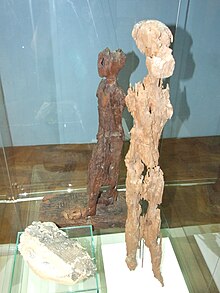Kekheretnebti
| Kekheretnebti | |
|---|---|
| Princess of Egypt | |
 Wooden statue of the Princess Khekeretnebti, found in the mastaba of Abousir - Náprstek Museum in Prague | |
| Burial | Mastaba B at Abusir |
| Issue | Tisethor |
| Dynasty | Fifth Dynasty of Egypt |
| Father | Djedkare Isesi |
Kekheretnebti or Khekeretnebty was a
Kekheretnebti was buried in a
Kekheretnebti was a full sister of princess Hedjetnebu who was buried in a tomb nearby. The examination of the skeletal remains show that the sisters showed some similarities and were both clearly related to Djedkare Isesi. Archaeological evidence shows that Kekheretnebti's tomb was constructed first, soon followed by the construction of the tomb of her sister Hedjetnebu. A scribe to the royal children named Idu had a tomb constructed a short time after the tomb construction for the princesses.[3]
Burial site
The burial mastaba of Kekheretnebti is nineteen meters long and fifteen meters wide and built of limestone and brick. It has a single entry on its eastern side which gives access to a suite of rooms arranged in a row. Despite having been looted by
References
- ISBN 978-0-500-05128-3
- ^ Deutsche Morgenländische Gesellschaft (1989), Zeitschrift für ägyptische sprache und altertumskunde, Volumes 116-118, p. 72
- ^ Miroslav Verner, Archaeological Remarks on the 4th and 5th Dynasty Chronology, pg 363-418, Archiv Orientální 69 (2001), No. 3
- ^ Deutsche Morgenländische Gesellschaft (1978), Zeitschrift für ägyptische sprache und altertumskunde, Volumes 105-108, p. 162
